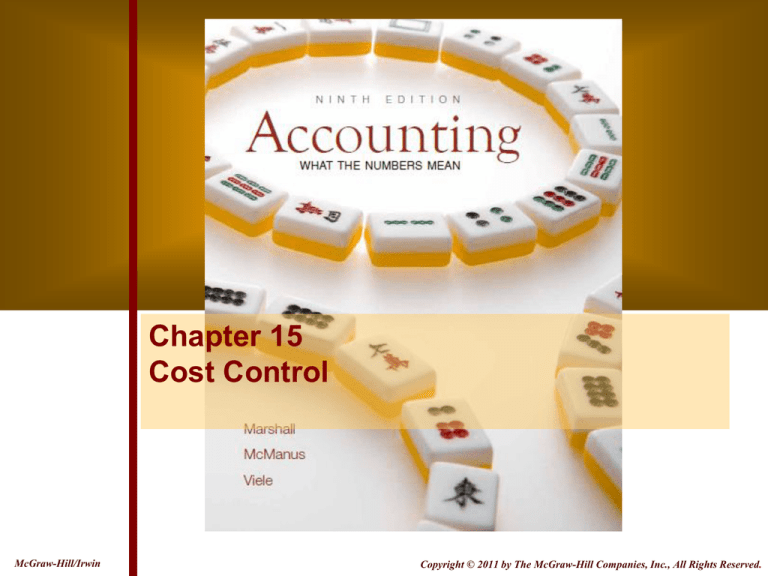
1-1
© 2008 The McGraw-Hill Companies, Inc., All Rights Reserved.
Chapter 15
Cost Control
McGraw-Hill/Irwin
McGraw-Hill/Irwin
15-1
© 2008
The ©
McGraw-Hill
Companies,
Inc., All
Reserved.
Copyright
2011 by The McGraw-Hill
Companies,
Inc.,Rights
All Rights
Reserved.
1-2
Cost Classification According
to a Time-Frame Perspective
Degree of Control
LO1
Costs that may not
be controllable in the
short run are controllable
in the long run.
Time
McGraw-Hill/Irwin
15-2
© 2008 The McGraw-Hill Companies, Inc., All Rights Reserved.
1-3
LO2
Performance Report Characteristics
Activity
Budget
Amount
–
Actual
Amount
=
Variance
Explanation
Favorable
•Actual revenues > Budgeted revenues
•Actual costs < Budgeted costs
Unfavorable
•Actual revenues < Budgeted revenues
•Actual costs > Budgeted costs
McGraw-Hill/Irwin
15-3
© 2008 The McGraw-Hill Companies, Inc., All Rights Reserved.
1-4
The Flexible Budget
LO3
To
a budget for different activity levels, we
must know how costs behave with changes in
activity levels.
• Total variable costs change
in direct proportion to
changes in activity.
• Total fixed costs
remain unchanged
within the relevant
range.
McGraw-Hill/Irwin
Fixed
15-4
© 2008 The McGraw-Hill Companies, Inc., All Rights Reserved.
1-5
LO4
Standard Cost Variance Analysis
Standard Cost Variances
Price Variance
Usage Variance
The difference between
the actual price and the
standard price
The difference between
the actual quantity and
the standard quantity
McGraw-Hill/Irwin
15-5
© 2008 The McGraw-Hill Companies, Inc., All Rights Reserved.
1-6
LO4
Standard Cost Variance Analysis
Actual Quantity
×
Actual Price
Actual Quantity
×
Standard Price
Standard Quantity
×
Standard Price
Price Variance
Usage Variance
AQ(AP - SP)
SP(AQ - SQ)
AQ = Actual Quantity
AP = Actual Price
McGraw-Hill/Irwin
SP = Standard Price
SQ = Standard Quantity
15-6
© 2008 The McGraw-Hill Companies, Inc., All Rights Reserved.
1-7
Materials Variances
Summary
LO5
Actual Quantity
×
Actual Price
22,500 yds.
×
$2.05 per yd.
= $46,125
Actual Quantity
×
Standard Price
22,500 yds.
×
$2.10 per yd.
= $ 47,250
Price variance
$1,125 favorable
McGraw-Hill/Irwin
Standard Quantity
×
Standard Price
21,800 yds.
×
$2.10 per yd.
= $45,780
Usage variance
$1,470 unfavorable
15-7
© 2008 The McGraw-Hill Companies, Inc., All Rights Reserved.
1-8
LO5
Labor Variances Summary
Actual Hours
×
Actual Price
Actual Hours
×
Standard Price
2,540 hours
×
$12.95 per hr.
2,540 hours
×
$12.80 per hr.
2,600 hours
×
$12.80 per hr.
= $32,512
= $33,280
= $32,893
Rate variance
$381 unfavorable
McGraw-Hill/Irwin
Standard Hours
×
Standard Price
Efficiency variance
$768 favorable
15-8
© 2008 The McGraw-Hill Companies, Inc., All Rights Reserved.
1-9
Variable Overhead
Variances Summary
LO5
Actual Hours
×
Actual Rate
Actual Hours
×
Standard Rate
Standard Hours
×
Standard Rate
2,540 hours
×
$3.20 per hour
2,540 hours
×
$3.20 per hour
2,600 hours
×
$3.20 per hour
= $8,128
= $8,128
= $8,320
Spending variance
$0
McGraw-Hill/Irwin
Efficiency variance
$192 favorable
15-9
© 2008 The McGraw-Hill Companies, Inc., All Rights Reserved.
1-10
Analysis of Fixed
Overhead Variances
LO6
Overhead costs are applied to products and
services using a predetermined overhead
application rate (POHAR):
Applied Overhead = POHAR × Standard Activity
POHAR
McGraw-Hill/Irwin
=
Estimated Fixed Overhead
Estimated Total Direct Labor Hours
15-10
© 2008 The McGraw-Hill Companies, Inc., All Rights Reserved.
1-11
Analysis of Fixed
Overhead Variances
LO6
Budget Variance
Volume Variance
Results from paying more
or less than expected for
overhead items.
Results from operating
at an activity level
different from the
planned activity.
McGraw-Hill/Irwin
15-11
© 2008 The McGraw-Hill Companies, Inc., All Rights Reserved.
1-12
Accounting for Variances
LO7
Net
Unfavorable
Variance
Insignificant
Net Favorable
Variance
Production
inefficiency
costs included in
Product cost
included in
Current
Period
Cost
Cost of
Goods
Sold
McGraw-Hill/Irwin
Significant
Net Favorable
Variance
Product cost
allocated between
Inventory
15-12
© 2008 The McGraw-Hill Companies, Inc., All Rights Reserved.
1-13
LO8
Methods of Evaluating
Segments
Segment
Evaluation Measures
Cost
Center
Actual costs are compared
to budgeted costs
Profit
Center
Actual segment margin is
compared to budgeted
segment margin
Investment
Center
Actual Return on investment
is compared to budgeted
return on investment
McGraw-Hill/Irwin
15-13
© 2008 The McGraw-Hill Companies, Inc., All Rights Reserved.
1-14
LO9
Analysis of Investment Centers
Return on investment (ROI) is the ratio of
segment margin to the investment used
to generate the segment margin.
ROI =
ROI =
Segment margin
Divisional operating assets
Segment margin
Sales
Margin
McGraw-Hill/Irwin
×
Sales
Operating assets
Turnover
15-14
© 2008 The McGraw-Hill Companies, Inc., All Rights Reserved.
LO9
Residual Income – Another
Measure
Segment margin
less required return
on operating assets
1-15
Segment margin
– Required return
= Residual income
Operating assets
× Required ROI
= Required return
McGraw-Hill/Irwin
15-15
© 2008 The McGraw-Hill Companies, Inc., All Rights Reserved.
1-16
LO9
The Balanced Scorecard
Financial Perspective
How do we look
to the firm’s owners?
Learning and Growth
Perspective
How can we continually
improve and create value?
Integrated
measures
Internal Business
Process Perspective
In which activities
must we excel?
Customer Perspective
How do our
customers see us?
McGraw-Hill/Irwin
15-16
© 2008 The McGraw-Hill Companies, Inc., All Rights Reserved.




